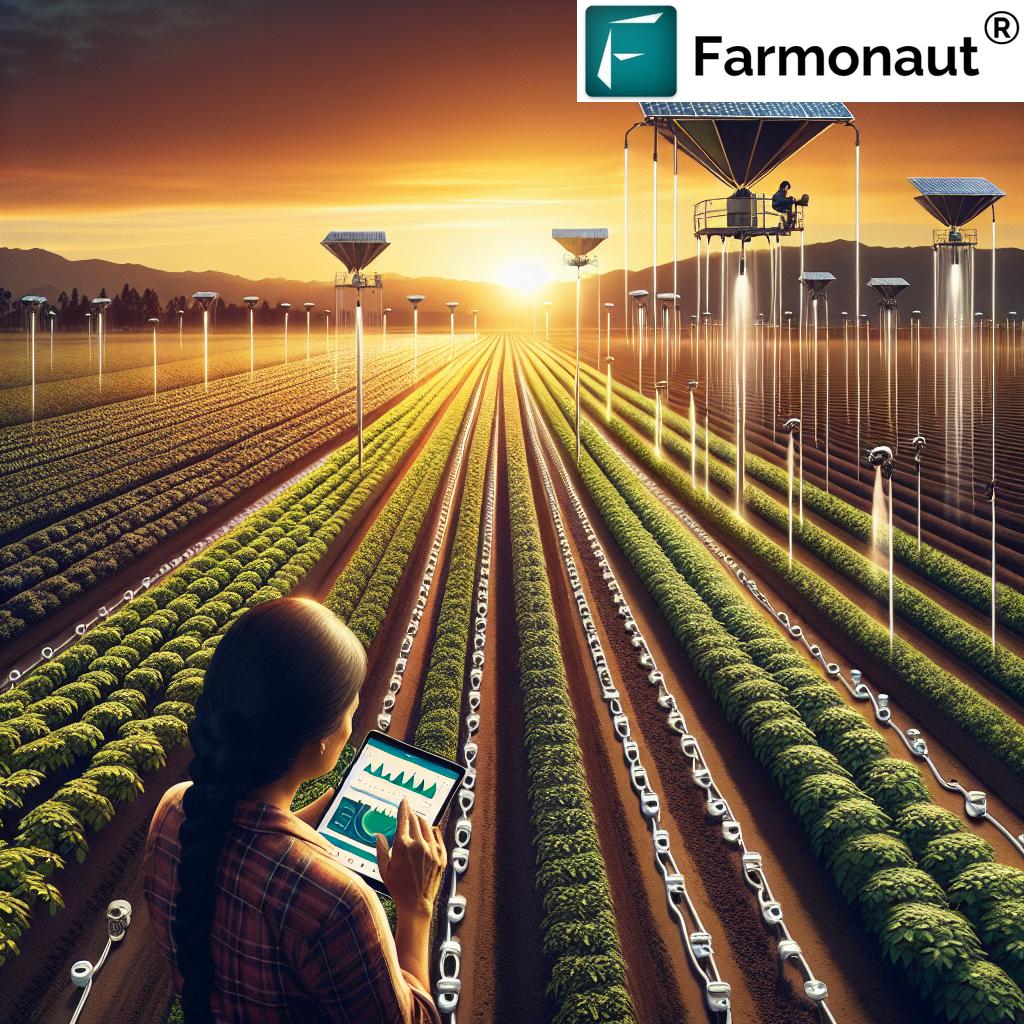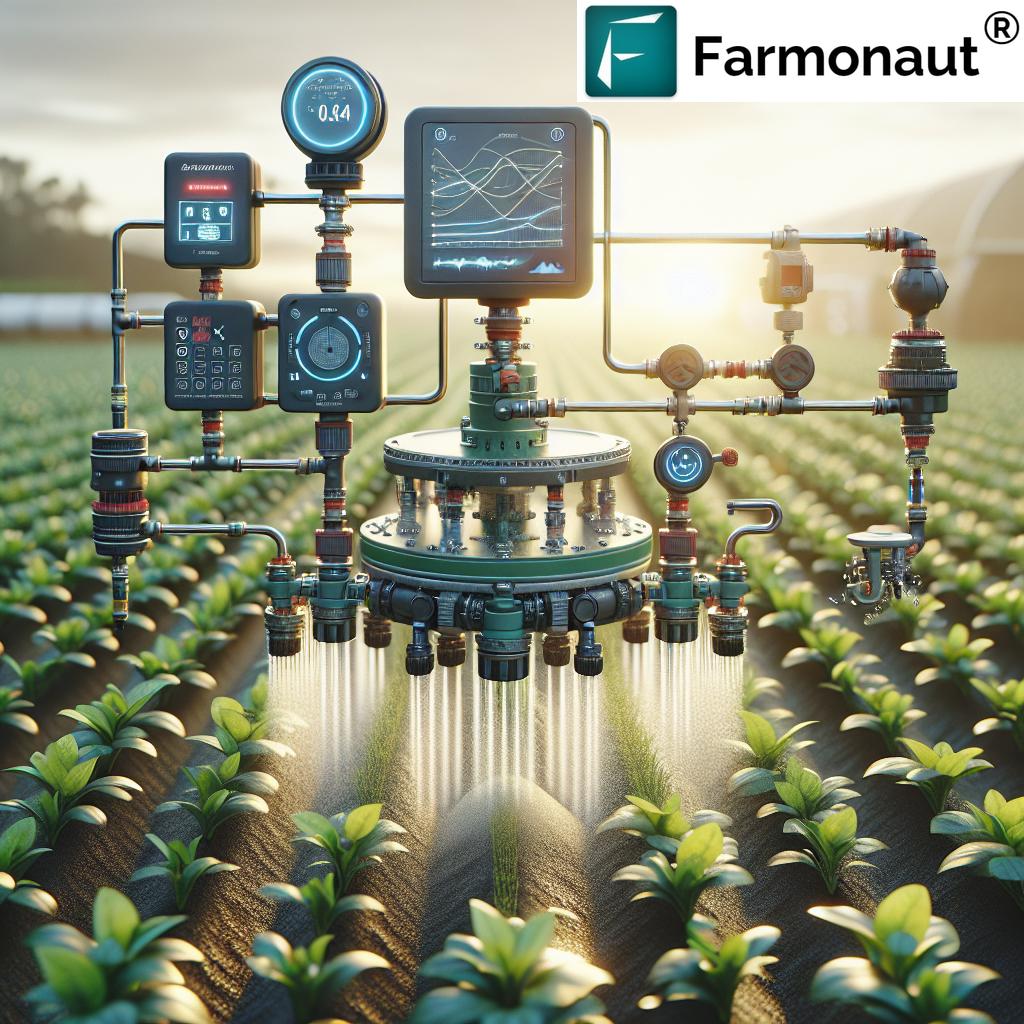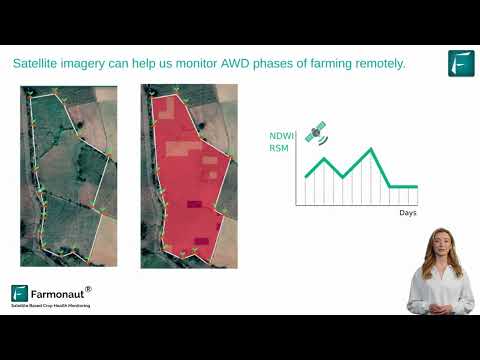Revolutionizing California Farms: Smart Irrigation Automation Systems for Water-Efficient, Sustainable Agriculture
“California farms using smart irrigation systems can reduce water usage by up to 30% compared to traditional methods.”
In the heart of America’s agricultural landscape, California stands as a testament to both the bounty and challenges of modern farming. As we navigate the complexities of 21st-century agriculture, we find ourselves at a crucial crossroads where innovation meets necessity. The Golden State, known for its diverse and bountiful specialty crops, is facing a perfect storm of water scarcity, labor shortages, and stringent regulations. In this evolving scenario, smart irrigation automation systems are emerging as a beacon of hope, promising a future where sustainable agriculture and water efficiency go hand in hand.
Today, we’ll dive deep into the world of precision irrigation technologies and explore how they’re transforming California’s farms. From leak detection in irrigation lines to real-time crop monitoring, we’ll uncover the innovative solutions addressing the most pressing issues in modern agriculture. Join us as we explore the revolution in water management that’s not just changing how we farm, but potentially securing the future of agriculture in water-stressed regions worldwide.
The California Water Crisis: A Catalyst for Change
California’s agricultural sector is no stranger to challenges, but the ongoing water crisis has pushed the industry to its limits. With recurring droughts and increasing competition for water resources, farmers are feeling the squeeze like never before. The state’s groundwater supplies, long considered a safety net during dry periods, are rapidly depleting, leading to the implementation of the Sustainable Groundwater Management Act (SGMA). This regulatory framework aims to achieve groundwater sustainability, but it also places additional pressure on farmers to optimize their water usage.
“Over 80% of California’s water supply is used for agriculture, making efficient irrigation crucial for sustainability.”
In this context, the need for water-efficient farming practices has never been more critical. Traditional irrigation methods, while familiar, often lead to significant water waste through evaporation, runoff, and overwatering. Enter smart irrigation automation systems – a game-changing technology that promises to revolutionize how we approach water management in agriculture.
Understanding Smart Irrigation Automation Systems
Smart irrigation automation systems represent a paradigm shift in agricultural water management. These advanced technologies integrate various components to create a holistic approach to irrigation:
- Soil Moisture Sensors: These devices measure the water content in the soil, providing real-time data on when irrigation is needed.
- Weather Stations: On-site weather monitoring helps in adjusting irrigation schedules based on local conditions.
- Smart Controllers: The brain of the system, these devices use data from sensors and weather stations to automate irrigation scheduling.
- Flow Meters and Valves: These components monitor water usage and control the flow, enabling precise application of water.
- Leak Detection Systems: Advanced sensors that can identify and alert farmers to leaks in irrigation lines, preventing water waste.
By leveraging these technologies, smart irrigation systems can dramatically improve water usage efficiency, often achieving 85-95% efficiency compared to the 60-70% typical of traditional methods.

The Benefits of Smart Irrigation Automation
The adoption of smart irrigation automation systems brings a multitude of benefits to California’s farms:
- Water Conservation: By applying water only when and where it’s needed, these systems can reduce water usage by up to 30%.
- Increased Crop Yield: Precise irrigation leads to healthier plants and potentially higher yields.
- Labor Savings: Automation reduces the need for manual irrigation management, addressing labor shortage issues.
- Cost Reduction: While initial investment may be high, long-term savings on water and labor often result in a positive ROI.
- Regulatory Compliance: Smart systems help farmers meet stringent water use regulations more easily.
- Environmental Stewardship: Reduced water usage and runoff contribute to more sustainable farming practices.
These benefits are not just theoretical. Across California, farmers implementing smart irrigation systems are seeing tangible results in water savings and crop health.
Overcoming Challenges in Adoption
Despite the clear advantages, the adoption of smart irrigation automation systems faces several hurdles:
- Initial Costs: The upfront investment in hardware and installation can be substantial.
- Technical Expertise: Many farmers need training to effectively use and maintain these systems.
- Connectivity Issues: Rural areas may face challenges with reliable internet connectivity needed for real-time data transmission.
- Integration with Existing Systems: Retrofitting older irrigation setups can be complex and costly.
To address these challenges, various initiatives are underway. Government grants, educational programs, and partnerships between tech companies and agricultural institutions are helping to ease the transition to smart irrigation technologies.
Real-Time Crop Monitoring: A Game Changer
One of the most exciting aspects of smart irrigation systems is their ability to provide real-time crop monitoring. This feature allows farmers to:
- Track crop health indicators
- Detect early signs of stress or disease
- Make data-driven decisions about irrigation and fertilization
- Optimize resource allocation across different sections of their farms
Real-time monitoring is particularly crucial for specialty crop farms, where precise management of water and nutrients can significantly impact crop quality and yield. By leveraging this technology, farmers can respond quickly to changing conditions, potentially saving entire crops from drought stress or overwatering.
Leak Detection: Saving Every Drop
Water loss through leaks in irrigation systems is a significant issue in California agriculture. Smart irrigation systems address this problem head-on with advanced leak detection capabilities. These systems can:
- Continuously monitor water flow rates
- Detect anomalies indicative of leaks
- Send immediate alerts to farmers or automatically shut off problematic sections
- Provide detailed reports on water usage patterns
By promptly identifying and addressing leaks, farms can save thousands of gallons of water annually, contributing to both cost savings and environmental conservation efforts.
The Role of AI and Machine Learning
Artificial Intelligence (AI) and Machine Learning (ML) are playing an increasingly important role in smart irrigation systems. These technologies enable:
- Predictive irrigation scheduling based on historical data and weather forecasts
- Automated adjustments to irrigation plans in response to changing conditions
- Advanced crop health analysis using image recognition technology
- Optimization of water usage across complex farm layouts
As these technologies continue to evolve, we can expect even more sophisticated and efficient irrigation management solutions in the future.

Sustainable Agriculture: Meeting Regulatory Requirements
California’s agricultural sector is subject to some of the most stringent water regulations in the country. Smart irrigation systems are proving invaluable in helping farmers meet these requirements:
- SGMA Compliance: By optimizing water usage, these systems help farms stay within allocated groundwater limits.
- Water Quality Management: Precise irrigation reduces runoff, helping to meet water quality standards.
- Reporting and Documentation: Automated data collection simplifies the process of regulatory reporting.
As regulations continue to evolve, the adaptability of smart irrigation systems will become even more crucial for California’s farmers.
The Future of Smart Irrigation in California
Looking ahead, we see several exciting trends in the development of smart irrigation technologies:
- Integration with Drone and Satellite Imagery: Enhanced crop monitoring through aerial and space-based observations.
- IoT (Internet of Things) Expansion: More interconnected devices for comprehensive farm management.
- Advanced Analytics: Deeper insights into crop health and water usage patterns.
- Robotics: Automated systems for physical inspection and maintenance of irrigation infrastructure.
These advancements promise to make smart irrigation systems even more powerful tools for sustainable agriculture in water-stressed regions like California.
Comparison: Traditional vs. Smart Irrigation Systems in California Agriculture
| Features | Traditional Irrigation | Smart Irrigation Automation |
|---|---|---|
| Water Usage Efficiency | 60-70% efficiency | 85-95% efficiency |
| Labor Requirements | High – manual monitoring and adjustments | Low – automated with minimal human intervention |
| Leak Detection Capability | Limited – often detected late | Advanced – real-time detection and alerts |
| Real-time Crop Monitoring | Manual, intermittent | Continuous, data-driven insights |
| Regulatory Compliance | Challenging to meet and document | Easier compliance with automated reporting |
| Cost-effectiveness | Lower initial cost, higher long-term expenses | Higher initial investment, long-term savings |
| Drought Resilience | Limited adaptability | High adaptability to water scarcity |
| Sustainability Impact | Higher water and energy consumption | Reduced resource use, lower environmental impact |
Case Study: Implementing Smart Irrigation in California Vineyards
While we can’t provide specific case studies about Farmonaut, let’s explore a hypothetical scenario of smart irrigation implementation in California vineyards:
A family-owned vineyard in Napa Valley decided to implement a smart irrigation system to address water scarcity issues and improve wine quality. The system included:
- Soil moisture sensors placed at various depths and locations
- A weather station to monitor local conditions
- Smart valves connected to a central controller
- A user-friendly mobile app for remote monitoring and control
Results after one year of implementation:
- 25% reduction in water usage
- 15% increase in grape quality (measured by sugar content and flavor compounds)
- 50% decrease in time spent on irrigation management
- Full compliance with local water use regulations
This example illustrates the potential benefits of smart irrigation systems in specialty crop farming, particularly in water-sensitive crops like wine grapes.
The Role of Farmonaut in Smart Agriculture
While Farmonaut is not directly involved in irrigation hardware, its satellite-based farm management solutions complement smart irrigation systems beautifully. Farmonaut’s platform offers:
- Satellite-based crop health monitoring
- AI-driven advisory systems for farm management
- Real-time insights into vegetation health and soil moisture levels
These features can enhance the effectiveness of smart irrigation systems by providing broader context and additional data points for decision-making.
Explore Farmonaut’s solutions:
For developers interested in integrating Farmonaut’s data into their own systems, check out the Farmonaut API and API Developer Docs.
Addressing the Labor Shortage Through Automation
The agricultural labor shortage in California has been a persistent challenge, exacerbated by changing immigration policies and competing industries. Smart irrigation automation systems offer a partial solution to this issue by:
- Reducing the need for manual irrigation management
- Allowing existing workforce to focus on higher-value tasks
- Providing opportunities for upskilling workers in technology use
While these systems cannot completely replace human labor, they can significantly alleviate the pressure on farms struggling with workforce shortages.
The Economics of Smart Irrigation
Investing in smart irrigation automation systems represents a significant upfront cost for many farmers. However, the long-term economic benefits can be substantial:
- Reduced water costs
- Lower energy expenses for pumping
- Decreased labor costs
- Potential for increased crop yields and quality
- Minimized crop loss due to over or under-watering
Many farmers find that the initial investment is recouped within 2-5 years, depending on the scale of implementation and specific crop types.
Environmental Impact and Sustainability
Beyond the economic benefits, smart irrigation systems contribute significantly to environmental sustainability:
- Conservation of water resources
- Reduction in energy use for pumping and distribution
- Minimized runoff and soil erosion
- Decreased use of fertilizers and pesticides through precise application
These environmental benefits align well with California’s push towards sustainable agriculture and can help farms meet increasingly stringent environmental regulations.
Challenges and Considerations
While the benefits of smart irrigation automation are clear, there are several challenges and considerations that farmers must navigate:
- Technology Adoption: Overcoming resistance to change and ensuring proper training for farm staff.
- Data Security: Protecting sensitive farm data in increasingly connected systems.
- System Reliability: Ensuring consistent performance, especially in areas with poor connectivity.
- Scalability: Adapting systems to work effectively across diverse crop types and farm sizes.
- Integration: Seamlessly incorporating smart irrigation with other farm management technologies.
Addressing these challenges will be crucial for the widespread adoption of smart irrigation systems across California’s diverse agricultural landscape.
The Future of California Agriculture
As we look to the future, smart irrigation automation systems are poised to play a pivotal role in shaping California’s agricultural sector. We anticipate:
- Increased adoption of precision agriculture technologies
- Greater integration of AI and machine learning in farm management
- Development of more drought-resistant farming practices
- Shift towards more sustainable and environmentally friendly agricultural methods
These trends, driven by technological innovation and necessity, will help California maintain its position as a leading agricultural producer while addressing critical water and labor challenges.
Conclusion: A Water-Efficient Future for California Farms
The adoption of smart irrigation automation systems represents a significant leap forward in addressing California’s agricultural challenges. By dramatically improving water efficiency, reducing labor demands, and enabling precise crop management, these technologies are paving the way for a more sustainable and productive farming future.
As we continue to face the realities of climate change, water scarcity, and evolving regulatory landscapes, the importance of these innovative solutions cannot be overstated. Smart irrigation systems, complemented by advanced technologies like those offered by Farmonaut, are not just tools for today’s farmers – they are essential investments in the future of agriculture.
The journey towards widespread adoption may have its challenges, but the potential rewards – for farmers, consumers, and the environment – are immense. As California leads the way in this agricultural revolution, the rest of the world watches and learns, setting the stage for a global transformation in how we approach farming in water-stressed regions.
The future of California agriculture is smart, efficient, and sustainable – and it starts with embracing the power of smart irrigation automation systems.
FAQs
- What is smart irrigation automation?
Smart irrigation automation refers to systems that use sensors, weather data, and AI to optimize water usage in agriculture, automatically adjusting irrigation based on real-time conditions. - How much water can smart irrigation systems save?
Smart irrigation systems can reduce water usage by up to 30% compared to traditional methods, significantly contributing to water conservation efforts. - Are smart irrigation systems cost-effective for small farms?
While the initial investment can be substantial, many small farms find smart irrigation systems cost-effective in the long run due to water savings, increased yields, and labor reduction. - How do smart irrigation systems help with regulatory compliance?
These systems provide precise water usage data and automated reporting, making it easier for farmers to comply with water use regulations and document their conservation efforts. - Can smart irrigation systems work with existing farm equipment?
Many smart irrigation systems can be integrated with existing equipment, though some upgrades may be necessary for optimal performance.






